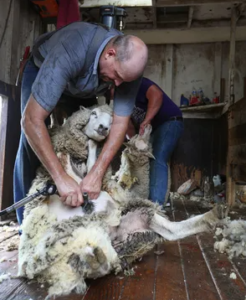YODER — Tony Seibert has raised sheep on his Reno County farm for decades. One day 30 years ago, he decided to learn to sheer them. He went to shearing school on the Kansas State Fairgrounds and soon entered into the profession part-time.
Seibert shears sheep throughout central Kansas, traveling from farm to farm. When he first started, he met 3-year-old Levi Homeier. That year, Levi watched Seibert intently, absorbing as much as he could. Each year thereafter, the little boy continued to watch Seibert shear his father’s sheep.
Eventually, Homeier apprenticed with Seibert. Now, whenever Seibert gets a large flock to shear, he calls in Homeier. “He’s like family,” Seibert said. “We work well together.”
Shearing sheep is an ancient custom dating back thousands of years. Sheep are one of the first animals to become domesticated. According to Encyclopedia Britannica, this occurred at around 10,000 BCE. Sheep must have their coat trimmed at least once a year. Excess wool increases the animal’s body temperature.
That is why Dedra and Steve Sawatzky, who own Sawatzky Farms just west of Yoder, call in Seibert to shear their 400 sheep each year. They usually have him come about a month or two before their lambs are born.
“It gets (the wool) off their back so their babies can find their food,” said Dedra Sawatzky. “It keeps them cooler.”
In addition, if their fleec e is not trimmed, pests, parasites, urine, and feces might harbor inside their wooly coat. Also, if their coat becomes too long, the animal might become immobile and unable to run away from danger with the rest of the flock.
e is not trimmed, pests, parasites, urine, and feces might harbor inside their wooly coat. Also, if their coat becomes too long, the animal might become immobile and unable to run away from danger with the rest of the flock.
Peter Orwick, the executive director of the American Sheep Industry Association, said the number of shearers has gone down, but he added, some of this decrease in numbers is because some sheep producers in Texas are using sheep that shed their coat. So, they do not need to be shorn, but some of the decrease in workers is in both the seasonality of the job and the difficult aspect of it.
“There is a trend in a number of these agricultural professions where you’re seeing fewer people participating,” Orwick said. Orwick, who lives in Colorado, said shearers definitely need to be trained. North Dakota and Washington offer classes each year. Others states do as well. Some classes are for the novice, but others are to keep professional shearer’s skills up.
The ASI will facilitate a new program this fall to help shearers in the U.S. work six months in the states and six months in either Australia or New Zealand. This way, they can have a fulltime job. “There are fewer and fewer shearers than there used to be,” Seibert said. “There are a lot more in Montana, South Dakota, Utah and Wyoming.”
As of January 2021, there were more than 5 million head of sheep in the U.S. Although there are sheep farms in all 50 states, most of the larger ones are west of the Mississippi River with the majority, 730,000, grazing in Texas. Colorado raises 445,000 sheep and Kansas has about 70,000, according to the ASI.
As for farms, according to the ASI, there are a little more than 100,000 sheep farms in the nation. Kansas ranks 28, having about 1,200 farms that raise the animal.
“We have the largest frame and the largest carcass sheep in the world,” Orwick said. “There are 300 pound rams and 200 pound ewes.”
Large-scale slaughter houses for the lambs are in both Colorado and Texas, but Kansas farmers are able to process their lambs at some small to medium sized plants across the Sunflower State as well.
Dedra and Steve Sawatzky bring their lambs to Yoder Meats and Central Livestock. Their lamb meat can be bought at Yoder Meat in Yoder and Wichita locations.
The wool from their flock, however, is sent to Illinois for processing. That plant focuses on large quantities of wool. “They grade each fleece and put it with like fleeces to sell to the wool mill,” Siebert said. There are also smaller fiber factories in Kansas, including HLA Fiber Mill of Augusta and Shepherd’s Mill in Phillipsburg.
As for the Sawatzky’s rams, they get shorn during the spring. “We sheared them in May before they went with the girls,” Dedra Sawatzky said. “We always shear them in May, so they’re nice and calm.”
The Sawatzkys raise Dorset and Montadale sheep. The ewes weigh around 175 pounds on average. The rams are well over 200 pounds.
Steve Sawatzky grew up on a blueberry farm in Canada, but Debra Sawatzky grew up near Yoder on the sheep farm she helps run. With great care and gentleness she rounds up the ewes for sheering, helping them move along the line. Boss, the family dog, who also protects the sheep from predators, watches the animals get shorn.
The Sawatzky’s three grown children help with the farm. Paul, 24, works the farm, which includes crops, full-time. Sam, 22, and Grace, 18, help when they can. Debra Sawatzky’s parents help with the farm.
Both Seibert and Homeier raise sheep as well. Seibert has about 25, while Homeier raises around 200. When they sheer, the two start with the stomach and work their way around the body, keeping the coat in one piece. As reported in The Hutchinson News.




